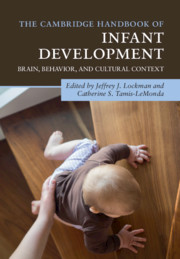Book contents
- The Cambridge Handbook of Infant Development
- The Cambridge Handbook of Infant Development
- Copyright page
- Dedication
- Contents
- Illustrations
- Contributors
- Preface
- Part I Foundations
- Part II Perceptual Development
- Part III Cognitive Development
- Part IV Action
- Part V Language
- Part VI Emotional and Social Development
- 25 Infant Attachment (to Mother and Father) and Its Place in Human Development
- 26 Infant Emotion Development and Temperament
- 27 Infant Emotional Development
- 28 Understanding and Evaluating the Moral World in Infancy
- 29 Cross-Cultural Perspectives on Parent–Infant Interactions
- Index
- References
27 - Infant Emotional Development
from Part VI - Emotional and Social Development
Published online by Cambridge University Press: 26 September 2020
- The Cambridge Handbook of Infant Development
- The Cambridge Handbook of Infant Development
- Copyright page
- Dedication
- Contents
- Illustrations
- Contributors
- Preface
- Part I Foundations
- Part II Perceptual Development
- Part III Cognitive Development
- Part IV Action
- Part V Language
- Part VI Emotional and Social Development
- 25 Infant Attachment (to Mother and Father) and Its Place in Human Development
- 26 Infant Emotion Development and Temperament
- 27 Infant Emotional Development
- 28 Understanding and Evaluating the Moral World in Infancy
- 29 Cross-Cultural Perspectives on Parent–Infant Interactions
- Index
- References
Summary
Infants are emotional. From peals of laughter to disconsolate crying, infants are notorious for both the intensity and lability of their emotional displays. From the 1-year-old’s distress in pursuing a retreating parent to the 2-year-old’s joyful pursuit of a favorite pet, emotion appears to be a central motivator of infant action. Infancy is also characterized by rapid emotional development. Neonates exhibit high rates of crying, but by 6 months broad-mouthed smiles are a common feature of social play. Infants develop sadness expressions in the first year, demonstrate empathy by 2 years, and pride by 3.
Keywords
- Type
- Chapter
- Information
- The Cambridge Handbook of Infant DevelopmentBrain, Behavior, and Cultural Context, pp. 742 - 776Publisher: Cambridge University PressPrint publication year: 2020
References
- 4
- Cited by



